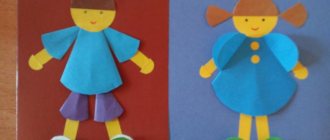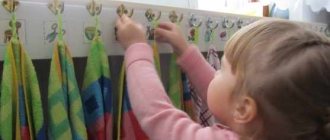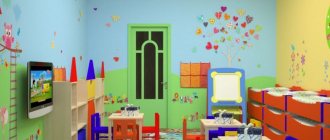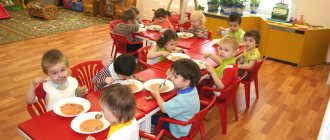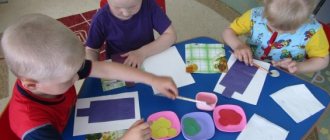How long can you study in kindergarten: Onishchenko’s advice
The question of how much can and should be done in a kindergarten or mini-kindergarten often worries parents. On the one hand, it is important that the child develops well. It especially pleases parents’ pride when a child is ahead of his peers in development. On the other hand, depriving a child of his childhood is criminal. Today we will talk about what the state thinks about classes in kindergarten and together we will read SanPiN 2.4.1.2660-10. “Sanitary and epidemiological requirements for the design, content and organization of the work regime in preschool organizations.”
This document was put into effect by a decree of the Chief State Sanitary Doctor Gennady Onishchenko. SanPiN is mandatory for compliance in preschool educational institutions, private kindergartens, mini-kindergartens and any other similar institutions.
So, for children aged 1.5 to 3 years, the duration of direct educational activity cannot exceed 1.5 hours a week and 10 minutes before lunch and after bedtime. As can be seen from the established standards, educational activities for the youngest children in kindergarten should be limited. Most of the time should be spent playing, outdoor games, exercise and sleep.
At older ages, the volume of permissible educational load in kindergarten increases. In the fourth year of life, it is permissible to study 2 hours 45 minutes per week, in the fifth - 4 hours, in the sixth - 6 hours 15 minutes, and finally in the preparatory group - 8 hours 30 minutes.
Also, at older ages, the duration of continuous educational activities has been increased: 15 minutes for the fourth year of life, 20 minutes for the fifth, 25 minutes for the sixth, 30 minutes for the preparatory group in kindergarten. The maximum load volume before lunch in the junior and middle groups must not exceed 30 and 40 minutes, respectively. For senior and preparatory groups, the educational load can be increased to 45 minutes and 1.5 hours, respectively. Classes must be interrupted by physical education, and breaks between classes must be at least 10 minutes.
Please note that in all cases mentioned above, we are talking about direct educational activities . If elements of educational activity are contained in games and physical activities, then this time is not taken into account when normalizing the load on a child in kindergarten.
Educational activities with children in kindergarten should be carried out in the first half of the day. Only with pupils of senior preschool age is it permissible to conduct classes after a nap. Although there are additional restrictions here too. They should take place a maximum of 2 - 3 times a week, last up to 25 - 30 minutes and must be interrupted by physical education.
Additional education in kindergarten is also regulated. The duration of classes in clubs, sections, studios is - for children of the 4th year of life - 1 time per week (no more) for up to 15 minutes; - for children 5 and 6 years of age - maximum 2 times a week for up to 25 minutes; — for children 7 years of age — 3 times a week, one lesson no more than 30 minutes.
Please note that the above standards do not only apply to activities where children sit at tables. You need to engage in physical education and creativity for at least 50% of the total time allotted for classes.
Finally, in kindergartens and mini-kindergartens there cannot be homework. Vacations should be provided for preschool children. During the holidays, only recreational and creative activities are allowed. Also during the holidays you should walk and move more.
If you are interested in the topic of SanPiN for preschool organizations, read the article “How many children per teacher should there be in a kindergarten: Onishchenko’s advice” on the website of the Teremok mini-kindergarten.
What knowledge do preschoolers acquire in math classes?
Mathematics classes in the senior group of kindergarten teach children to correctly distinguish between geometric shapes that are similar in shape, for example, a square and a rectangle, as well as analyze objects and describe their shape, evaluate sizes using three indicators: length, width and height.
In older preschoolers, the ability to determine in words how objects are located relative to each other (right, left, in front), to freely navigate in space (standing near a locker, in front of a table, behind a chair), to change the direction of one’s movement (to the right, to the left) and remember the names of the days of the week, as well as their sequence.
Instructions for the teacher for conducting classes
In order for classes in a group of older preschoolers to be effective and interesting for children, the teacher should follow some rules.
- Classes in kindergarten in the senior group involve the presentation of new, rather complex material in the form of a game. This develops visual memory and imaginative thinking well. In addition, the competitive element present in them spurs children to better assimilate knowledge.
- It is worth devoting sufficient time to repetition. But it is not necessary to do this during the lesson; you can do several repetition sessions at the beginning of the month.
- In order not to lose children's attention, you need to monitor the change in their activities. Various types of exercises, games, songs, riddles and dances should be interspersed.
And remember that adults should communicate with children only in a friendly manner. Under no circumstances should you use a commanding tone in class, much less scold a child.
Preschoolers
Children of preschool age constantly produce something “with a twist”: they sing songs and compose poems with original rhymes and rhythm, tell stories about characters they have invented, perform unprecedented dances and show “tricks”, draw pictures in which it is sometimes difficult to guess the meaning. . But all this is a necessary and very important stage in a child’s life. While he does not need frameworks, instructions and advice on how to do it “right”. The baby absorbs what surrounds him and creates his own interpretation. Even if it sometimes seems ridiculous to us, there is no need to stop a child from creating.
Parents of a preschooler must provide the child with a favorable environment that stimulates development. Now your baby actively imitates everything he likes. Mom draws - and he draws scribbles, dad assembles furniture - and he wants to screw in a screw somewhere, grandma knits - and he wants to try. The actions of adults become an incentive for the child to create his own. You may have noticed that small children like their own dances, scribbled “letters,” and clumsily molded plasticine figures. And attempts by adults to teach “how it should be done” are met with hostility or ignored. This is a natural way of protecting your right to be a discoverer, a creator.
Parents should encourage their child in his endeavors, set an example for him with his activities and provide the necessary materials and accessories for a particular activity. This approach will be much more effective than any regular classes (no matter in clubs or at home).
Why are mugs needed?
Activities have their place in a child’s life, but their choice and the start time of attendance should be taken seriously. The clubs that a preschooler attends must be appropriate for his age and not cause unnecessary stress (physical and psychological). In addition, any activity should first of all be genuinely enjoyed by the child. Fashion, prestige and visiting “for company” are not the best criteria for choosing a circle. Do not forget that interests in preschool age are still unstable, and the child is still just trying out different types of activities.
Atmosphere in the middle group of kindergarten
Among the tasks that the teacher solves, a special place is occupied by the development of relationships between four-year-old children. He teaches them to coordinate actions, accept a common goal and strictly follow it. The teacher makes sure that every child is able to experience joy from the results of joint activities and treat everything around him kindly. It teaches kids to respond emotionally to the states of other people and to show kind feelings towards plants and animals. In the course of joint activities, the teacher develops children’s creative expressions and fosters interest in participating in various games. He also encourages students to engage in artistic activities, teaches them to experience success and joy from the fact that they managed to realize their plans.
Child's age
It is better to start specialized training for a child (drawing, singing, dancing, professional sports) no earlier than 5-6 years. This age is the starting point for “real” learning, i.e. It becomes easier for the child to repeat, to follow a model, and he gradually moves away from childish spontaneity.
Don’t be afraid that you will miss time and your baby will not receive something. On the contrary, in comparison with peers who attended various sections from a very early age, he will be more free in self-expression, will better understand his desires and capabilities, and will have a sincere interest in the classes. For children whose purposeful parents sent them, say, to professional sports at the age of 3, it can be difficult to understand later whether this is really “their” business.
If we talk about specific types of activities, then for the youngest (from 2 years old) we can only recommend physical education and rhythm classes - this is useful for harmonious development. It is better to start learning singing no earlier than 5 years old, music - no earlier than 6 years old. A child will be ready to learn music theory from the age of 7-8.
Dancing , despite its seemingly obvious benefits, causes a lot of controversy among parents. On the one hand, they contribute to the physical and aesthetic development of the child, but on the other hand, questions arise as to why these activities are needed at all: for pleasure or as a professional sport with all the ensuing consequences. You can dance for pleasure at 3-4 years old, but in a circle this will in any case be training, which prevents the child from inventing his own (albeit savage) dances. But a child will be able to start real training aimed at participating in competitions and championships no earlier than 5 years old.
The situation is approximately the same with professional sports . There is no need to rush: if the child is still small, and you choose a sport for the “future champion” for your own reasons (most often investing heavily financially), you are thereby depriving him of the opportunity to make independent choices in the future. In addition, professional sports do not have the best effect on the child’s health and psyche, so the decision on such a choice should be determined by the child’s real desires and abilities. And of course, he should be given for serious training no earlier than 5-6 years.
You can take a child under 5 years old to the pool The child will be able to adequately perceive the trainer’s instructions and carry them out upon reaching 5-6 years of age. This applies not only to professional sports (you want to raise an Olympic champion), but also to simple learning to swim.
Drawing is undoubtedly very useful for children, even six-month-old babies. However, mastering drawing techniques should not begin until 4-6 years of age.
Foreign language classes are very attractive to parents, because early childhood development schools promise that they will teach even a 3-year-old to speak a foreign language (or even more than one!). Indeed, 3 years is the most susceptible age for language acquisition. But still, the speech is primarily native. Early learning of a foreign language causes confusion in a child’s head, which prevents him from mastering his native language, which is formed only by the age of 6-8. Of course, there are children growing up in bilingual families, but they should be discussed separately. Speech therapists warn about the dangers of early learning a foreign language. In particular, dysgraphia is possible, a writing disorder that is quite common among modern schoolchildren. That's why speech therapists advise not to rush into a foreign language. If you are clearly determined to teach your child foreign languages as early as 3-4 years old, choose just one and do not forget that classes should take place in a playful way. In addition, language classes in the future will have to be regular, otherwise they will completely lose their meaning - the child will simply forget everything he was taught.
Should a first grader be overloaded with clubs?
With the start of school, the child begins a new life, to which he adapts more or less successfully. Parents, naturally, want their first-grader to develop not only academically, but also to engage in additional sports, music, or something else.
From a psychological point of view, it is wrong to enroll a child in all kinds of clubs from the first days of school. Give your child time to get used to new conditions, adapt to the team, educational requirements and workloads. Even if it seems to you that everything is going smoothly, take your time.
Does your child enjoy learning? He made friends in the class, studies are easy, and he has a lot of free time? I just want to occupy him with something useful. The right start! But you still need to approach it sensibly. Here are some tips:
- Don't overload your child. If all his time is scheduled minute by minute, the result will not be joy from a fulfilled life, but fatigue and frayed nerves.
- The number of clubs and the time spent attending them should depend on the individual characteristics and needs of the child. For the average student, the normal number of classes will be no more than two times a week on weekdays, plus once on a weekend. Also take into account how far the selected circles are from home. Constant trips to different parts of the city will exhaust the child.
- If your child is not persevering, it makes sense to enroll him in several clubs at once. He will try, find “his own” and stop there.
- It is better to immediately introduce a calm and diligent child to only one or two main activities. Otherwise, later, as the school load increases, when he has to choose between several clubs in favor of the most important ones, it will be difficult for him to give up things on which so much effort and time have already been spent.
- Between school and extracurricular activities, children must be given a break for rest - at least 1 hour.
